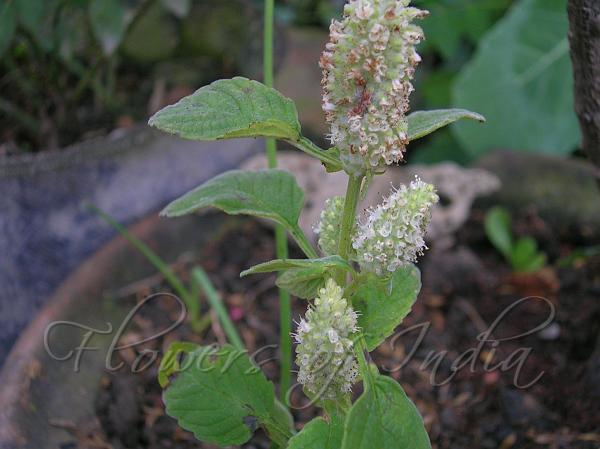|
| Lomba |
|

|

| File size | 702396 |
| Original date | 11/10/14 3:02 AM |
| Resolution | 2048 x 1536 |
| Flash | Flash did not fire, auto |
| Focal length | 8.0mm |
| Exposure time | 1/52s |
| Aperture | 3.2 |
| Focus Distance | |
| Metering Mode | Partial |
| Camera make | NIKON |
| Camera model | E3700 |
| Sensor type |
|
|
|
|
Photo: |
Botanical name: Elsholtzia griffithii Family: Lamiaceae (Mint family)
Lomba is an annual herb up to 50 cm tall, with strong lemony
fragrance. Stems are erect, sometimes purple-red, densely covered with white velvet-hairy,
much branched at base. Leaf-stalks are 2-5 mm, densely white velvet-hairy.
Leaves are
ovate to oblong, above white hairy, below velvet-hairy,
yellowish glandular, margin sawtoothed. Tiny lilac or white flowers are
borne in spikes at branch-ends, which are cylindric, compact, 1-4.5 cm long,
0.8-1 cm wide. Axis is densely
white hairy; bracts linear, up to 3.5 mm, densely white hairy. Flower-stalks
are
about 1 mm, densely white hairy. Calyx is tubular, up to 4 mm in fruit, tip
recurved, densely gray woolly-hairy outside; teeth nearly equal, slightly
closed in fruit. Flowers are funnel-shaped, about 3 mm, hairy, glandular
outside, obscurely hairy annulate inside; upper lip oblong, notched,
fringed with hairs; lateral lobes of lower lip less than half as wide as
middle lobe. Stamens are 4, protruding out, hairless. Nutlets are 4, oblong,
about 0.7 mm, sparsely brown hairy. Lomba is used in seasoning food
in NE India. It is found in disturbed forest or mountain valleys, at
400-600 m altitude, in NE India. It is also widely cultivated in NE
India. Flowering: October-December.
Medicinal uses: Lomba is used as
tonic, astringent, carminative and antiseptic. Decoction of
leaves and flowers is given in tonsilities, fever, cough, high
blood pressure, nose bleeding, menstraual disorder,
treatment of body itching
Lomba is used as
tonic, astringent, carminative and antiseptic. Decoction of
leaves and flowers is given in tonsilities, fever, cough, high
blood pressure, nose bleeding, menstraual disorder,
treatment of body itching
Medicinal uses:
 Lomba is used as
tonic, astringent, carminative and antiseptic. Decoction of
leaves and flowers is given in tonsilities, fever, cough, high
blood pressure, nose bleeding, menstraual disorder,
treatment of body itching
Lomba is used as
tonic, astringent, carminative and antiseptic. Decoction of
leaves and flowers is given in tonsilities, fever, cough, high
blood pressure, nose bleeding, menstraual disorder,
treatment of body itching| Photographed in Imphal, Manipur. |
• Is this flower misidentified? If yes,